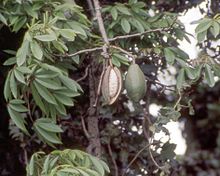| Ceiba | |
|---|---|

| |
| Ceiba pentandra leaves and fruit | |
| Scientific classification | |
| Kingdom: | Plantae |
| Clade: | Tracheophytes |
| Clade: | Angiosperms |
| Clade: | Eudicots |
| Clade: | Rosids |
| Order: | Malvales |
| Family: | Malvaceae |
| Subfamily: | Bombacoideae |
| Genus: | Ceiba Mill.[1] |
| Species | |
|
19, see text | |
| Synonyms[2] | |
| |
Ceiba is a genus of trees in the family Malvaceae, native to tropical and subtropical areas of the Americas (from Mexico and the Caribbean to northern Argentina) and tropical West Africa.[3] Some species can grow to 70 m (230 ft) tall or more, with a straight, largely branchless trunk that culminates in a huge, spreading canopy, and buttress roots that can be taller than a grown person. The best-known, and most widely cultivated, species is Kapok, Ceiba pentandra, one of several trees known as kapok. Ceiba is a word from the Taíno language meaning "boat" because Taínos use the wood to build their dugout canoes.[4][5]
Ceiba species are used as food plants by the larvae of some Lepidoptera (butterfly and moth) species, including the leaf-miner Bucculatrix ceibae, which feeds exclusively on the genus.
Recent botanical opinion incorporates Chorisia within Ceiba and puts the genus as a whole within the family Malvaceae.[3]
- ^ "Ceiba Mill". Germplasm Resources Information Network. United States Department of Agriculture. 2003-06-05. Archived from the original on 2009-05-07. Retrieved 2009-10-13.
- ^ Cite error: The named reference
potwwas invoked but never defined (see the help page). - ^ a b A TAXONOMIC REVISION OF THE GENUS CEIBA MILL.(2003)
- ^ María Elena Gutiérrez L. "En Recursos Biológicos" (in Spanish). Escuela de Ingeniería de Antioquía, Colombia. Archived from the original on 2 April 2015. Retrieved 22 March 2015.
- ^ "Ceiba pentandra" (PDF) (in Spanish). Comisión Nacional para el Conocimiento y Uso de la Biodiversidad: 65. Retrieved 4 October 2022.
{{cite journal}}: Cite journal requires|journal=(help)